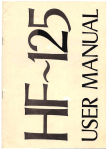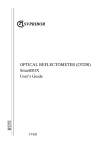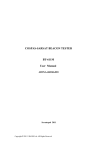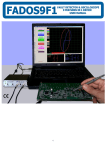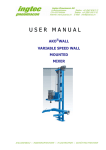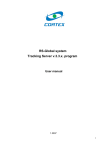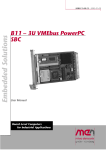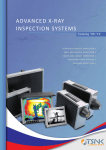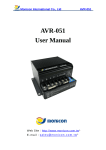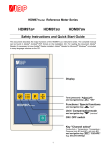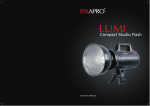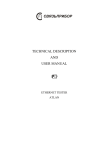Download TRACE-LOCATOR P-410 MASTER USER`S MANUAL
Transcript
TRACE-LOCATOR P-410 MASTER USER’S MANUAL SVPRIBOR 2 CONTENTS 1 FUNCTION _______________________________________ 4 2 ENVIRONMENTAL SPECIFICATION__________________ 4 3 SPECIFICATION __________________________________ 5 4 SUPPLIED ACCESSORIES __________________________ 5 5 PRINCIPLE OF OPERATION and DEVICE CONSTRUCTION _________________________________________ 5 5.1 5.2 6 PREPARING TO WORK _____________________________ 6 6.1 6.2 6.3 7 Defect Tracing With Amplitude Methods _______________15 Defect tracing in insulation by phase method ____________16 Defect tracing in coat insulation of FOL ________________18 Short-circuit in Cable Core Tracing ___________________18 Defining interrupts in cable core ______________________18 Defining interrupts in ropes or pipelines ________________18 DEVICE TESTING ________________________________ 19 9.1 9.2 9.3 9.4 10 11 12 13 MAP Mode _______________________________________9 LEVEL Mode ____________________________________11 Trace search at the bottleneck of supply lines____________12 Branch Lines Search _______________________________14 SPECTRUM mode ________________________________14 DEFECT TRACING _______________________________ 15 8.1 8.2 8.3 8.4 8.5 8.6 9 Getting started _____________________________________6 LCD and Menu ____________________________________7 Sensitivity and Auto-sensitivity _______________________8 TRACING ________________________________________ 9 7.1 7.2 7.3 7.4 7.5 8 Principle Of Operation ______________________________5 Device Construction ________________________________6 Conditions _______________________________________19 Means of Testing _________________________________19 Testing __________________________________________19 Depth measuring tuning ____________________________20 SHIPPING and STORAGE ________________________ PRECIOUS METALS ____________________________ WARRANTY ___________________________________ TEST CERTIFICATE ____________________________ 22 22 22 22 3 1 FUNCTION Trace-locator P-410-MASTER was carefully designed to help with: 1) Trace searching, verifying the underground and open cable lines (open transmission lines) and power cables; metal cords and pipelines (water-, oil- and gas pipelines); supply pipelines that have metallic coat or metallic conductors; 2) continuous positional and directional checking, occurrence depth and current flow in underground supply lines; 3) “maximum”- “minimum” search method; 4) guidance control for channel-identification of signal in line/pipe bottleneck or cable bundles; 5) direct sound locating for orientating in complicated situations and trace-locating of noisy wires; 6) controlling of received frequencies in wideband mode (spectrum); 7) trace-searching in wideband mode; 8) phase (contactless) method of tracing in copper wire coating and fiber optic links (FOL); 9) tracing of cable interruption or cable core short circuits. In active mode the P-410-MASTER allows you to verify 3-frequency signal and could be used as a unit with TC-310А-2 transmitter, TC-210А-2, TC-210А, TC-21А, as well as with any transmitter 6562,5 ± 1 Hz or (and) 2187,5 ± 1 Hz or (and) 273,5 ± 0,5 Hz frequency. In passive mode – without using a transmitter – Trace-locator could be used as a controller of received frequencies and for trace-searching of power cables, tracelocating of noisy wires, massive metallic supply lines, and supply lines with metallic coating (pipelines, ropes, etс.). The Trace-Locator is power supplied by 4-Ni-Mh A-type batteries with 2,3 А/hrs capacity. This provides 13-hour continuous work of the device. Trace-indication could be done visually and with acoustic reception signal (using headphones and built-in emitter). 2 ENVIRONMENTAL SPECIFICATION • • • 4 Operation temperature Relative air humidity Air pressure −20 ÷ +50оС to 90% at 30оС 86 ÷ 106 kPa 3 SPECIFICATION Active Frequency Bandwidth Amplitude –3 dB (≤) for frequency 6562,5 Hz for frequency 2187,5 Hz for frequency 273,5 Hz Depth Depth Measurement Accuracy Trace location accuracy Trace locating of insulation interruption with transitional resistance1 Spectrum Frequency Range Battery life (continuous operation) Battery Type Charging Time (≤) Dimensions Weight (with the battery) 4 45 Hz 15 Hz 2,5 Hz 6m ±5%+10 cm 10 cm 0 – 100 kOhm 10 ÷ 20 000 Hz 13 h 4-Ni-Mh АА type , 2,3 A/h. 4h 257х88х685 mm 1,9 kg SUPPLIED ACCESSORIES № 1. 2. 3. 4. 5. 5 6562,5 ± 1 Hz 2187,5 ± 1 Hz 273,5 ± 0,5 Hz Name P-410-MASTER Charge adapter 12 V, 0.5 A User’s manual Headphones Headphones Bag Pieces 1 1 1 1 1 PRINCIPLE OF OPERATION and DEVICE CONSTRUCTION 5.1 Principle Of Operation P-410-MASTER Trace Locator is a signal receiver for searching of underground lines, their depth and signal current, and also the locating of cable interruption. In active search mode (“Map”, “Level”, “LF-HF 273 Hz” or “Phase 6 kHz” modes) transmitter is the source of the sound frequency signal that being connected to core of the searched cable. Alternating current produces a magnetic field that induces 1 Amplitude and phase (contactless) methods. 5 a signal in the receiver inductive sensor. Sensors are located in the upper and lower parts of the receiver. Signals induced in the sensor then come into the receiving device where analog and digital processing is being done. Then the results are displayed on the LCD and sound emitter. In passive mode (”SPECTUM” mode) the receiver is being registered as an alternating magnetic field in frequency sound range with the source in the power cable with power current and noisy wire nets. 5.2 Device Construction The device was constructed as a monoblock. You can see the device in the pic.5.1. In the upper panel there are: • • and Keys of sensitivity LCD Display • - ON /OFF Menu Key • - Function Key АВТО In the lower panel there are: • • • - ON/OFF Key Headphones Outlet AC/DC Adaptor Outlet The 4-AA batteries compartment locates in the side face of the device. Pic.5.1. General view 6 PREPARING TO WORK 6.1 Getting started Carefully unpack the trace-locator and make sure it doesn’t have any visible mechanical damages of the case. If the device has been stored at hyper humidity or at low temperatures, wait for 24 hours before starting off. • 6 KEEP OUT WATER The Trace-Locator is power supplied by 4-Ni-Mh A-type batteries with 2,3 А/hrs capacity. This provides 13-hour continuous work of the device. Open the battery compartment under the lower panel of the device and insert the batteries in the correct direction by aligning the “+” and “–“ marks on the batteries with the polarity markings inside the battery compartment. • BEFORE USING MAKE SURE THE BATTERIES ARE FULLY CHARGED, IF NECESSARY PLUGS THE DEVICE IN! • KEEP THE BATTERIES AWAY FROM THE DEVICE TO AVOID THEIR DAMAGE Connect the AC power adaptor to the trace-locator and fully charge the batteries. The process of charging is displayed on the LCD. You can’t put the device on by the when being charged. New batteries require 10-12 full charge-discharge cycles to obtain maximum level of capacity. The charger indicates the level of operability of the batteries overcharged or defective batteries wouldn’t be charged. Every time before tracing the batteries should be charged. Before long-time storage or transporting charge the batteries in order to avoid their damage and take them out of the compartment. . If it is properly connected, then it’s serial number and Turn the device ON software version will be displayed. The Menu comes on as shown in pic.6.1. M enu Mаaрpт а К Level Sp e c tr u m Phase 6 kH z L F -H F 273 H z Pic. 6.1. MENU When the battery is low, the device turns off. 6.2 LCD and Menu Before using the trace-locator choose/set the mode. To change/set the mode use АВТО MENU. Enter the MENU using as shown in pic.6.1. MENU appears on the display. To change modes press АВТО from the set menu press and . To exit . 7 M od e fun ctio na l k ey “ F ” D e pt h Map F h = 9 см 7 0 dB S e ns itivity sc ale B a ttery c ha rg e le ve l S e ns itivity, d B Pic.6.2. DISPLAY PANEL Every mode name and function name are shown in the upper line on the display, in the lower line you can see the meaning of the gain controller in dB and the battery level. The example of “LEVEL” mode is shown in pic.6.2. Every mode is described in Table 1. Table 1. MENU Modes Available Measurements “MAP” “LEVEL” “LF-HF 273 Hz” “PHASE 6 kHz” “SPECTRUM” “Direct sound off” 6.3 Frequency Signal Level 2187,5 Hz Direction, Position, Signal Current, Depth Frequency Signal Level 2187,5 Hz Signal Current, Depth, Minimum and Maximum Modes Frequency Signal Level 273,5 Hz Difference of Frequency Signal Level 273,5 Hz and 2187,5 Hz Frequency Signal Level 6562,5 Hz Difference of Signal Phases 2187,5 Hz and 6562,5 Hz Received Signal Spectrum - Energo (10-500 Hz) and Wide (10-20000 Hz) Turn ON the “Direct sound” in SPECTRUM mode Sensitivity and Auto-sensitivity When tracing, press (<) or (>) to set the signal level up to 70-80 points. and simultaneously. To set the required level automatically, press In the lower line of the display you’ll see the sensitivity scale with grating period 2 dB and the meaning of sensitivity in dB. Pic 6.9. DISPALAY INDEX WHEN OVERLOADED If there’s a background noise, high sensitivity causes corrupted signal level. If so, OVERLOAD will be displayed. 8 7 TRACING To trace the underground line, connect the outlet of the transmitter with the 1st wire to the cable core and ground the 2nd wire. Grounding is usually done 10 - 20 м away from the trace. The distant end of the cable core must be grounded. The test signal transmitter must be connected to the metallic coat of the active cable. Tracing range will get lower. When searching pipelines or ropes, transmitter should be connected to the pipeline with the 1st wire and the 2nd wire must be grounded. Grounding is usually done 10 - 20 м away from the trace. Since pipelines and ropes are not insolated, the tracing range could vary from 0,2 to 5 km, depends on curtain circumstances. Turn the transmitter on. Set the “HF” mode. If there’s a lot of industrial noise, we recommend you to use the “HF-PAUSE” mode. Set MAP mode on the trace-locator. 7.1 MAP Mode Cable map has easy-readable graphic information that is handy for quick orienting. The mode combines all the innovation methods of tracing: measuring of the signal level, using minimum method of indicating above the cable, defining of “own/right-wrong” cable regarding the signal direction. Map Map 7 0 dB D ire c tio n F Map 7 0 dB D e pt h F 7 0 dB Pic.1. MAP Mode. Defining the signal direction 9 Do the preliminary tracing. The level of the signal will be displayed as a line or pointer. When you get the firm signal, the direction of the cable signal current will be defined in a few seconds (Pic 1,a), but the level indicator wouldn’t look as a pointer. Settle SYRIAN TELECOM Карта the required direction pressing (Pic. 1,b), then the indicator will be displayed as a pointer again. Pic. 2, shows the position of the trace-locator above the trace as displayed. When the pointer is in the middle of the cross-point, you can measure the depth pressing (Pic. 3). Глубина F 34 dB SENSITIVITY SVPRIBOR MENU P- 410-MASTER . I SYRIAN TELECOM Карта Глубина F 34 dB SENSITIVITY SVPRIBOR Map D e pth MENU P- 410-MASTER F I 7 0 dB Рic 3. The position when measuring of the depth is available. 10 Pic. 2. Cable MAP, а – the “right” cable is on the right side of the device: signal from the transmitter goes straight on through the cable; b – the “right” cable is on the left. 7.2 LEVEL Mode Use LEVEL mode to define the trace with permanent digital monitoring of the signal level with 2187,5 Hz frequency, depth and signal current2. Set LEVEL mode on the trace-locator. maximum 55 MIN F Function key “F” h = 11 см Depth I = 1,0 Signal current Frequency signal level 2187,5 Hz 36 dB Pic. 4. LEVEL mode Do tracing at maximum signal level. Maximum method of indicating helps you to determine approximate trace location. To gain more accurate measurement, use the minimum method mode. Pic. 5. Dependence of the signal level on the trace-locator position and the search mode 2 At weak signal, depth and signal current are not displayed 11 Every mode name and function name are shown in the upper line on the display. Press to switch the mode off. You can see dependence of the signal level on the trace-locator position and the search mode in Pic.5. When tracing at minimum method mode, follow the minimum signal level. This mode helps you to determine exact trace location. At LEVEL mode the trace with permanent digital monitoring of the depth and signal current are displayed. This measurements are correct at exact point of the tracelocator above the line (pic. 6). a ) correct measuring b) incorrect measuring ground h underground line Pic. 6. Depth and signal current measuring 7.3 Trace search at the bottleneck of supply lines At the bottleneck of supply lines the signal is received both from the cable, connected to the transmitter and from parallel supply lines. To trace the right cable different methods could be used. We recommend you to do the tracing connecting to the grounded distant end of the cable core. Turn the transmitter on. Current Direction Method. This method is based on the principle of the reverse current direction in the parallel supply lines. For this method permanent mode of the signal generation in the transmitter is preferable but you can also use any other mode. Set MAP mode on the trace-locator. 12 When the location of the trace out-off the bottleneck is determined, place the trace-locator above the “right” cable, and fix the direction of the cable. The signal level indicator would look as a pointer and it would stay like this till you move along the “right” cable. If you move opposite direction, you’ll hear a beep and the pointer will be redirected. The same thing happens if you switch to the near-by line. If the trace location is unknown, then choose the cable with the maximum signal level (the most correct results are gained at LF-HF 273 Hz mode in the trace-locator and LF-HF – in transmitter). Place the trace-locator above this cable and fix the direction. If this is the “right” cable, the rest of the cable would cause redirection. If this is the “wrong” cable, then only the signal from the “right” cable will redirect the pointer. At a low signal the pointer showing the direction starts blinking. If in 30 sec the level of the signal doesn’t increase, the given direction will be lost, and the level indicator will be displayed as a straight line. In this case you must set up a new direction. Current Measuring Method. This method is based on the fact that the current meaning from the induced signal in the near-by or parallel supply lines is lower than in the cable connected to the transmitter. You can use any process mode for the transmitter. Set LEVEL mode on the trace-locator. Fix the trace-locator above the cable, set the regular level of the signal, and you’ll see the signal current displayed. You should remember that incorrect meaning of the signal current appears only if the trace-locator is exactly above the trace. You can find detailed description of depth and signal current measuring in article 7.2. LF-HF method. This method is based on the fact that the HF induced signal in parallel or near-by supply lines is higher that in LF. Comparison of the signal levels at these frequencies allows determining the “right” cable at fine precision. L F -H F R e se t 69 15dB F F u nc tion key “F ” D e fe re nt sign al le vel F req ue ncy sign al le vel 27 3 H z 3 6 dB Pic. 7.7. LF-HF mode. Set LF-HF 273 Hz mode on the trace-locator. Set LF-HF mode on the transmitter. • Fix trace-locator exactly above the trace. • Specify the signal level in the scale range. • Null the meaning of the level difference pressing . 13 Moving along the trace, the meaning of the level difference will be progressively increasing (a few dB by 100 m) because of different or unequal signal propagation at 273 Hz and 2187,5 Hz frequencies in the cable. Big difference increase will be displayed when a “wrong” cable is detected. The meaning is correct regardless of switching the modes till the device is off. 7.4 Branch Lines Search Set LEVEL mode on the trace-locator. Do tracing as described in article 7.1. Do the branch lines searching setting the trace-locator parallelly the trace as shown in pic.7.8. In this case the signal level from the “right” cable is minimum (Pic 7.8.b), and the branch lines will cause big increase of the signal level (Pic 7.8.в). maximum MIN F h = 11 см 80 а) tracing I = 1,0 36 dB б)branch lines searching maximum MIN F h = 11 см 10 I = 1,0 36 dB в) branch line is detected maximum MIN F h = 11 см 80 I = 1,0 36 dB branch line trace Pic.7.8. Branch lines searching: а) tracing, б) branch lines searching, в) branch line is detected 7.5 SPECTRUM mode In passive mode – without using a transmitter – Trace-locator could be used as a controller of received frequencies and for trace-searching of power cables, tracelocating of noisy wires, massive metallic supply lines, and supply lines with metallic coating (pipelines, ropes, etс.). Set SPECTRUM mode on the trace-locator. You’ll see signal spectrum displayed in the frequency range at 10 ÷ 20 000 Hz (WIDE). Permanent frequency signal will be displayed on the sound emitter or headphones according to induced 14 signal level in antenna. Turn on the DIRECT SOUND mode to display the whole induced signal spectrum on sound emitter or headphones. In MENU switch Direct sound OFF to Direct sound ON. Set SPECTRUM mode on the trace-locator to continue the work. Use maximum signal level method to trace the supply lines location. Menu Sp e c tr u m PHA SE 6 kHzl L F -H F 2 7 3 H z C o n tra s t D ire c t s o u n d o ff Pic 7.9. MENU For detailed displaying of the spectrum at 10-500 Hz (ENERGO) press 8 . DEFECT TRACING 8.1 Defect Tracing With Amplitude Methods Amplitude method is based on reducing of the signal level in the place of defecting. When tracing the defects, it’s important to carefully measure the depth since the signal level depends on it. You should remember that signal level and signal current will be smoothly reducing as getting further from the transmitter because of the linear capacitance of the cable. Defect tracing in this method is also possible when the signal level and signal current are simultaneously controlled. The signal level reduces in the place of defect, so does the signal current. Sensitivity of the method is rather low, and this method could also be used in defect tracing at 1 кOhm. LF-HF 273 Hz Mode. The LF-HF method is based on comparising of the signal levels at 273 Hz and 2187,5 Hz frequencies. High-Ohm defects do not really influence the signal level at 2187,5 Hz frequency but you can notice significant reduction at 273 Hz. Comparising of the signal levels at these frequencies allow to determine the insulation defects with high accuracy. This method is more sensitive than the amplitude one and allows you to determine all the defects up to 10 kOhm. Set LF-HF 273 Hz mode on the trace-locator. Set LF-HF mode on the transmitter. Stationary fix the trace-locator above the trace. • Set the signal level up to 70-80 points. • Null the level difference meanings pressing . 15 While tracing, the meaning will be smoothly increasing (a few dB by100 m), because of the unequal signal propagation at 273 Hz and 2187,5 Hz. Significant difference increasing displays the place of defect. The meaning is correct regardless of switching the modes till the device is off. LF-HF Reset F 69 15dB Function key “F” Difference signal level Frequency signal level 273 Hz 36 dB Pic. 8.1. LF-HF 273 Hz mode 8.2 Defect tracing in insulation by phase method Phase method is used to trace the defects in insulation coat of cables where metallic coating is missing, as well as for tracing the defect in insulation coating of fiber optic links (FOL). Method is based on the principle that before the defect location, current in cable consists of capacitive current and resistive current leakage in the place of defect. When the place of defect is passed, current in cable has only capacitive constituent, and the phase of the signal current changes. Pic 8.2. The sensitivity of this method is lower than at contact method and depends on linear capacitance of the cable, as well as on the leakage location. The lower cumulative capacity in a certain piece after leakage of cable is, the higher the sensitivity will be. Maximum sensitivity equals 10 deviation in phase signal which helps to define the leakage up to 50 kOhm at 100 nF capacity in a certain piece after leakage. It’s important to remember that at this level the signal reduces and at the very end of the cable the meter may point low signal level where method doesn’t work. Keep controlling the deviation in phase signal in the pre-taken trace. Set LF-HF mode on the transmitter. Connect the outlet of the transmitter with the 1st wire to the cable core and ground the 2nd wire. Grounding is usually done 10 20 m away from the trace. The distant end of the cable core must be insolated. Set PHASE 6 kHz mode on the trace-locator. The meaning of the phase difference between signals 2187,5 Hz and 6252,5 Hz is displayed. Fix the traceand set locator firmly above the trace choose the sensitivity level pressing or the signal level not lower than at 70-80 points. The meaning of the difference between phase signals 2187,5 Hz and 6252,5 Hz is displayed. At low signal level there’s a possibility of measurement failure of phase signal. Null the meaning of the 16 phase pressing . “0 deg” readout must be stable. If it’s not possible to set “0 deg”, it means that the noise level is excessive. So you can’t apply the phase method of defect tracing. Phase Reset F Phase deg. 55 0 Phase Reset F Phase deg. 36 dB 55 10 36 dB Itransmitter Itransmitter IC IR IC IC-capacitive current IR-resistant current (defect current) Defect Pic. 8.2. Defect tracing by phase method Phase Reset F Function key “F” Phase deg. 9 15 Phase Frequency signal level 6562,5 Hz 70 dB Рисунок 8.3. PHASE 6 kHz mode To locate the defect moving along the trace do measuring of phase difference. The meaning of the difference will be progressively increasing (a degree unit by 100 m), because of different or unequal signal propagation at 273 Hz and 2187,5 Hz frequencies in the cable. Significant difference increase will be displayed when a defect is detected. To update the defect locations go back to the previous position and re-measure. At”20 deg.” level you’ll hear a beep. 17 8.3 Defect tracing in coat insulation of FOL To trace low-Ohm defects amplitude method is the most appropriate (effective). In complicated cases phase and HF-LF methods could be used. Defect tracing in coat insulation of FOL is implemented when moving along the trace and similar to defect tracing in copper cable insulation. Also remember that in this case all the mentioned methods are less sensitive because linear capacity of the FOL coating is much higher than in the copper cable. As a rule sensitivity ≤ kOhm units. 8.4 Short-circuit in Cable Core Tracing Connect the transmitter to the defective cable core. It’s recommended to work on the shortest piece of cable to reduce spurious signal through the cable capacity. Preferably to locate the defect closer to the distant end of the cable located aside from the transmitter. Short-circuit is defined by the sharp decreasing of the signal level so make sure to control the depth. You can also define short-circuit by decreasing the signal current. The most correct results are gained at LF-HF 273 Hz mode in the trace-locator and LF-HF – in transmitter but you should remember that the signal level in this case will be much lower. That’s why you should firstly use MAP or LEVEL mode and then locate the defects in LF-HF 273 Hz mode. 8.5 Defining interrupts in cable core Connect the outlet of the transmitter with the 1st wire to the поврежденной cable core and ground the 2nd wire. Grounding is usually done 10 - 20 m away from the trace. The distant end of the cable core must be insolated. Interrupt zone in amplitude method is defined by sharp decreasing of the signal level or current level in LEVEL mode. Specify the place of interruption at low frequency. Set LF-HF 273 Hz mode on the trace-locator. Set LF-HF mode on the transmitter but remember that the signal level will be much lower. 8.6 Defining interrupts in ropes or pipelines Since the insulation in pipelines and ropes coating is missing, the transmission range may vary between 0,2 to 5 km and also depends on certain conditions. Interruption in ropes or pipelines is defined by the same method as in the core cable. 18 9 DEVICE TESTING 9.1 − − − 9.2 Conditions air temperature 20 ± 2°С; relative humidity 65 ± 15%; air pressure 84 – 106 kPa. Means of Testing For testing you need the measuring means and secondary equipment (Table 2). Table 2. The list measuring means and secondary equipment Name Type Frequency meter Ч3-64 Wide-band Millivoltmeter В3-59 LF Transmitter Г3-118 Quantit Main Characteristics y 1 20 Hz – 20 кHz accuracy 1х10-5 1 mV - 300 V 1 accuracy 0,2х10-2 1 Resistor 1 1 kOhm Wire 10m Wire 0,75mm2 Notе: For testing other sample means with relevant metrological characteristics could be used. 9.3 Testing 9.3.1. To test the trace-locator you need to charge the battery and then unplug the adapter. Then connect the wire as shown in the pic. 9.1. wire Г3-118 1 kOhm Pic. 9.1. Diagram of the trace-locator testing 9.3.2. Sensitivity measuring of trace-locator Place the trace-locator vertically on the wire as shown in pic. 7.2. Set LEVEL mode on the trace-locator and set sensitivity at 44 dB. Set the generator at 19 2187,5 Hz±0,5 Hz and output signal level at 70 points. The resistor voltage measured with millivoltmeter must be at 200 mV. Set PHASE 6 kHz mode on the trace-locator and sensitivity at 44 dB. Set the generator at 6562,5 Hz±1 Hz and output signal level at 70 points. The resistor voltage measured with millivoltmeter must be at 2 V. Set LF-HF 273 Hz mode on the trace-locator and sensitivity at 44 dB. Set the generator at 273,5 Hz±0,5Hz and output signal level at 70 points. The resistor voltage measured with millivoltmeter must be at 1 В. 9.3.3. Frequency of maximum measuring Set LEVEL mode on the trace-locator, on the generator Set the generator at 2187,5 Hz±0,5 Hz and set sensitivity on the trace-locator at 50-90 points, changing the frequency define the maximum meaning of the signal level. The defined frequency measured with the frequency meter must fit the meaning in Table 3. Set PHASE 6 kHz mode on the trace-locator, on the generator Set the generator at 6562,5 Hz and set sensitivity on the trace-locator at 50-90 points, changing the frequency define the maximum meaning of the signal level. The defined frequency measured with the frequency meter must fit the meaning in Table 3. Set LF-HF 273 Hz mode on the trace-locator, on the generator Set the generator at 273,5 Hz and set sensitivity on the trace-locator at 50-90 points, changing the frequency define the maximum meaning of the signal level. The defined frequency measured with the frequency meter must fit the meaning in Table 3. 9.3.4. Bandwidth calibration is measured by level –3dB. To do this the signal level must be set at 70 points of the frequency of maximum, then at permanent signal level of the generator you must first increase the frequency to gain 50 points; then decrease it to gain the same point. The difference between upper and lower meanings of frequency defines the bandwidth that must fit the meaning in Table 3. Table 3. Active frequency, Hz: LEVEL mode PHASE 6 кHz mode LF-HF 273 Hz mode Bandwidth Amplitude –3 dB (≤) LEVEL mode, 2187,5 Hz PHASE 6 кHz mode, 6562,5 Hz LF-HF 273 Hz mode, 273,5 Hz 9.4 2187,5 ± 1 6562,5 ± 1 273,5 ± 0,5 15 Hz 45 Hz 2,5 Hz Depth measuring tuning Before running of the device, in order to gain the maximum frequency you may tune the depth measuring. To tune the device you need a separate cable with the certain (known) depth - h. Locate and tag the point above the cable center. Turn on tune mode on the device 20 pressing and press at the same time. In this mode MENU will display additional points: 1. SET DEPTH – Depth Tuning Function 2. DEFAULTS – Restore Factory Settings Function АВТО then follow Set SET DEPTH mode on the trace-locator and press instructions displayed on LCD: 1. “Set the device above the trace and press “OK” – set the device vertically at the АВТО tag point above the trace (Pic 9.2.а.), press . Tuning takes about 5 sec. 2. “Lift up the device at 50 sm and press “OK” – lift up the device 50 sm above the АВТО tag level vertically (Pic 9.2.b), press . Tuning takes about 5 sec. When the tuning is done, the trace-locator will be working on personal setting. Set LEVEL mode on the trace-locator and make sure that the displayed depth meaning matches the known depth - h. If necessary, you may go back to factory settings. In MENU choose АВТО Confirm using DEFAULTS and press . “DEFAULTS YES →NO», вchoosing “YES”. 3. a. the factory settings b. lift up the de vic e 50 сm above the ta g level v ert ica lly set the de vic e vertic ally at the tag point abov e the trace h+50 см h Trace Pic 9.2. Trace-locator position when tuning the depth 21 10 SHIPPING and STORAGE For shipping trace-locators must be done carefully packed according to the shipping rules and regulations. • BEFORE LONG-TIME SHIPPING TO AVOID THE DAMAGE TAKE THE BATTERIES OUT • BEFORE LONG-TIME STORAGE THE BATTERIES MUST BE FULLY CHARGED WARNING! Make sure that the condition in the storage rooms or warehouses satisfy the requirements for storing the devices and doesn’t have any dust, aggressive gas, acids or harmful crud that could cause rusting! 11 PRECIOUS METALS The device does not include any precious metals 12 WARRANTY Manufacturer guarantees operating capacity of the trace-locator within the warranty period only if all the required operating, storage, shipping conditions are carefully observed. Warranty period - 24 months from the sale date. Warranty does not cover the battery and charger. Manufacturer Address: RUSSIA, POBox 43100 SVPRIBOR 170043, TVER tel: +7-4822- 41-29-91, 72-52-76, 51-50-72 fax: +7-4822- 41-29-91 E-mail: [email protected] http://www.svpribor.ru 13 TEST CERTIFICATE P-410-MASTER, S/N ___________satisfies all the technical conditions and admitted and fits for service. Manufacture Date “___”________2008 Factory Representative (signature) _________ 22























